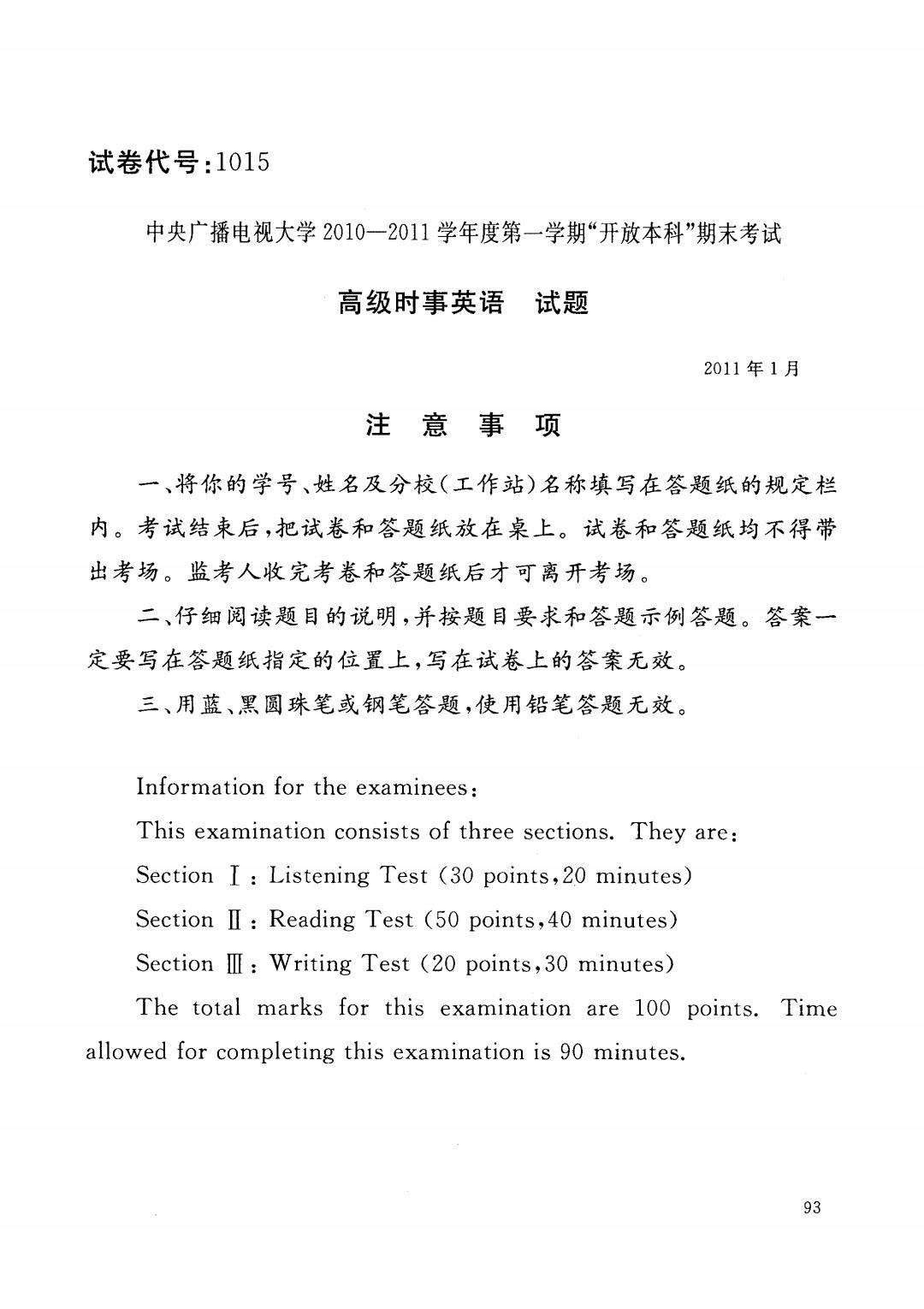
试卷代号:1015 中央广播电视大学2010一2011学年度第一学期“开放本科”期末考试 高级时事英语试题 2011年1月 注意事项 一、将你的学号、姓名及分校(工作站)名称填写在答题纸的规定栏 内。考试结束后,把试卷和答题纸放在桌上。试卷和答题纸均不得带 出考场。监考人收完考卷和答题纸后才可离开考场。 二、仔细阅读题目的说明,并按题目要求和答题示例答题。答案一 定要写在答题纸指定的位置上,写在试卷上的答案无效。 三、用蓝、黑圆珠笔或钢笔答题,使用铅笔答题无效。 Information for the examinees: This examination consists of three sections.They are: Section I:Listening Test (30 points,20 minutes) Section II:Reading Test (50 points,40 minutes) Section III:Writing Test (20 points,30 minutes) The total marks for this examination are 100 points.Time allowed for completing this examination is 90 minutes. 93
试卷代号 中央广播电视大学 2011 学年度第一学 放本 高级时事英语试题 2011 年1 注意事项 ·、将你的学号、姓名及分校(工作站)名称填写在答题纸的规定栏 内。考试结束后,把试卷和答题纸放在桌上。试卷和答题纸均不得带 出考场。监考人收完考卷和答题纸后才可离开考场。 二、仔细阅读题目的说明,并按题目要求和答题示例答题。答案 定要写在答题纸指定的位置上,写在试卷上的答案无效。 三、用蓝、黑圆珠笔或钢笔答题,使用铅笔答题无效。 Information for the examinees This examination consists of three sections. They are: Section I : Listening Test (30 points,20 minutes) Section II : Reading Test (50 points,40 minutes) Section ill : Writing Test (20 points, 30 minutes) The total marks for this examination are 100 points. Time allowed for completing this examination is 90 minutes. 93
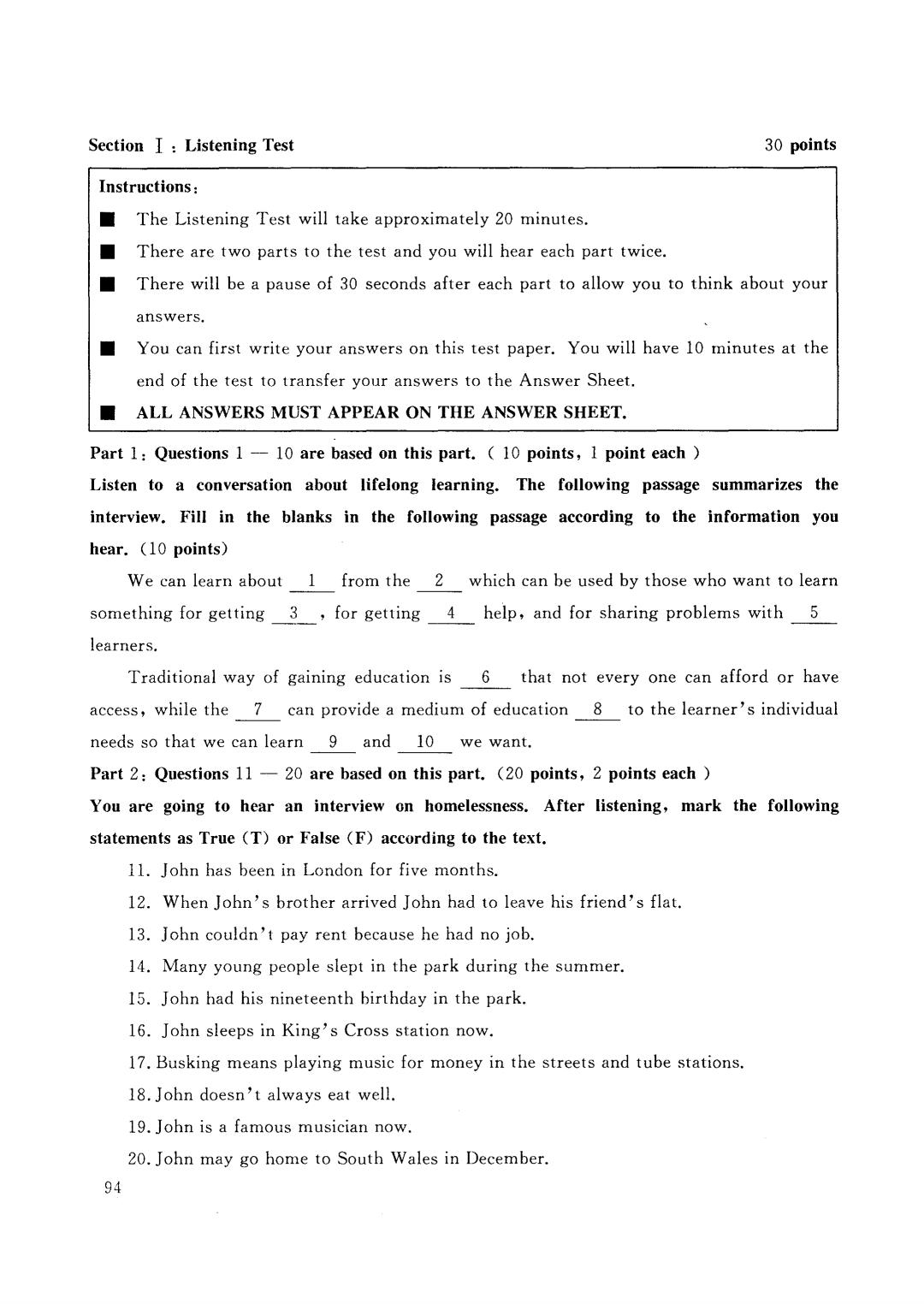
Section I Listening Test 30 points Instructions: ◆ The Listening Test will take approximately 20 minutes. ■ There are two parts to the test and you will hear each part twice. ■ There will be a pause of 30 seconds after each part to allow you to think about your answers. You can first write your answers on this test paper.You will have 10 minutes at the end of the test to transfer your answers to the Answer Sheet. ◆ ALL ANSWERS MUST APPEAR ON THE ANSWER SHEET. Part 1:Questions 1-10 are based on this part.(10 points,1 point each Listen to a conversation about lifelong learning.The following passage summarizes the interview.Fill in the blanks in the following passage according to the information you hear.(10 points) We can learn about 1 from the 2 which can be used by those who want to learn something for getting 3 for getting 4 help,and for sharing problems with 5 learners. Traditional way of gaining education is 6 that not every one can afford or have access,while the 7 can provide a medium of education 8 to the learner's individual needs so that we can learn 9 and 10 we want. Part 2:Questions 11-20 are based on this part.(20 points,2 points each You are going to hear an interview on homelessness.After listening,mark the following statements as True (T)or False (F)according to the text. 11.John has been in London for five months. 12.When John's brother arrived John had to leave his friend's flat. 13.John couldn't pay rent because he had no job. 14.Many young people slept in the park during the summer. 15.John had his nineteenth birthday in the park. 16.John sleeps in King's Cross station now. 17.Busking means playing music for money in the streets and tube stations. 18.John doesn't always eat well. 19.John is a famous musician now. 20.John may go home to South Wales in December. 94
Section I : Listening Test 30 points Instructions: Listening Test will take approximately 20 minutes. • There are two parts to the test and you will hear each part twice. • There will be a pause of 30 seconds after each part to allow you to think about your answers. • You can first write your answers on this test paper. You will have 10 minutes at the end of the test to transfer your answers to the Answer Sheet. • ALL ANSWERS MUST APPEAR ON THE ANSWER SHEET. from the , for getting 2 4 which can be used by those who want to learn help , and for sharing problems with 5
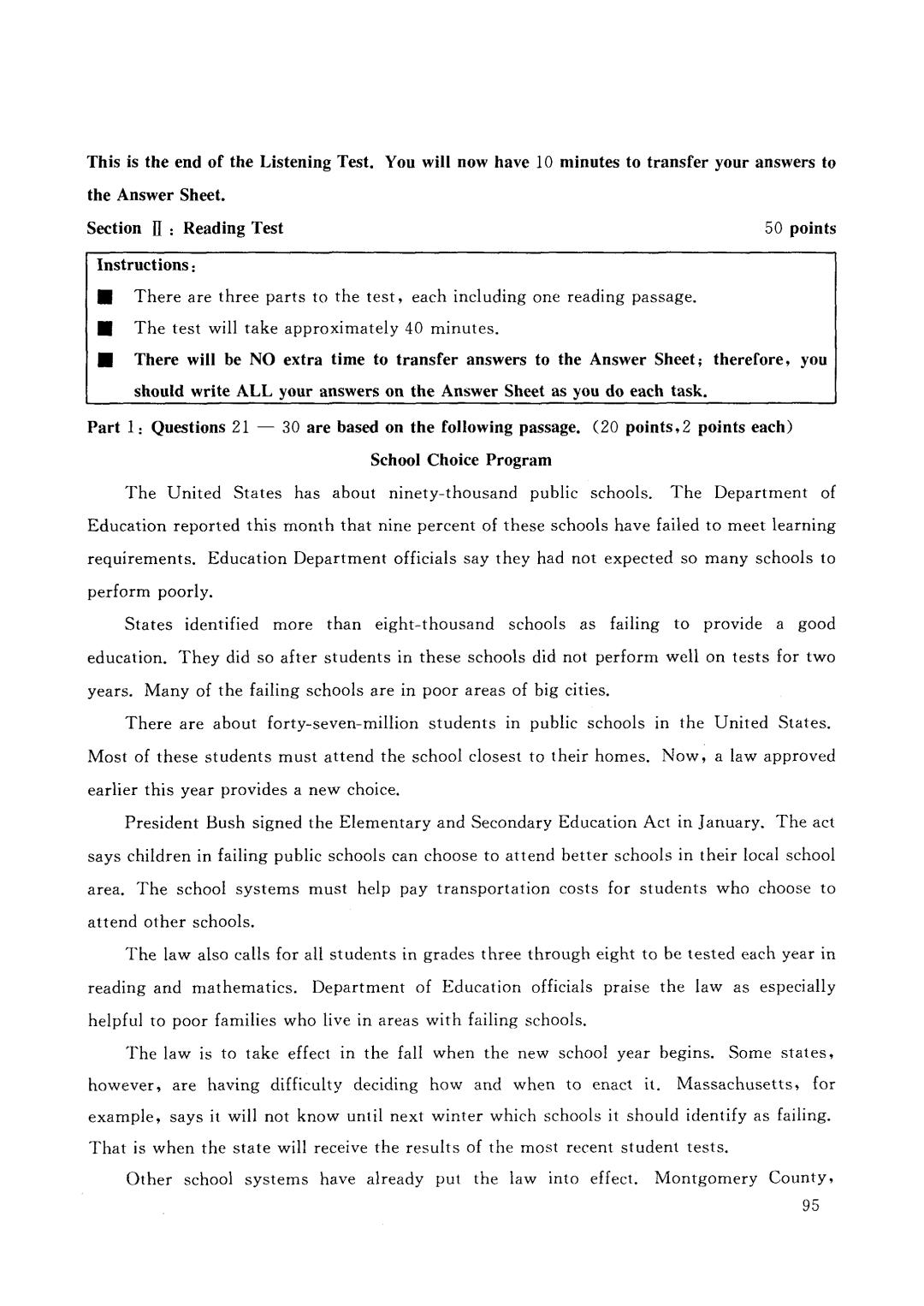
This is the end of the Listening Test.You will now have 10 minutes to transfer your answers to the Answer Sheet. SectionⅡ:Reading Test 50 points Instructions: ◆ There are three parts to the test,each including one reading passage. The test will take approximately 40 minutes. There will be NO extra time to transfer answers to the Answer Sheet;therefore,you should write ALL your answers on the Answer Sheet as you do each task. Part 1:Questions 21-30 are based on the following passage.(20 points,2 points each) School Choice Program The United States has about ninety-thousand public schools.The Department of Education reported this month that nine percent of these schools have failed to meet learning requirements.Education Department officials say they had not expected so many schools to perform poorly. States identified more than eight-thousand schools as failing to provide a good education.They did so after students in these schools did not perform well on tests for two years.Many of the failing schools are in poor areas of big cities. There are about forty-seven-million students in public schools in the United States. Most of these students must attend the school closest to their homes.Now,a law approved earlier this year provides a new choice. President Bush signed the Elementary and Secondary Education Act in January.The act says children in failing public schools can choose to attend better schools in their local school area.The school systems must help pay transportation costs for students who choose to attend other schools. The law also calls for all students in grades three through eight to be tested each year in reading and mathematics.Department of Education officials praise the law as especially helpful to poor families who live in areas with failing schools. The law is to take effect in the fall when the new school year begins.Some states, however,are having difficulty deciding how and when to enact it.Massachusetts,for example,says it will not know until next winter which schools it should identify as failing. That is when the state will receive the results of the most recent student tests. Other school systems have already put the law into effect.Montgomery County, 95
This is the end of the Listening Test. You will now have 10 minutes to transfer your answers to the Answer Sheet. Section II : Reading Test 50 points Instructions: • There are three parts to the test , each including one reading passage. test will take approximately 40 minutes. • There will be NO extra time to transfer answers to the Answer Sheet; therefore , you should write ALL your answers on the Answer Sheet as you do each task. Part 1: Questions 21 - 30 are based on the following passage. (20 points,2 points each) School Choice Program The United States has about ninety-thousand public schools. The Department of Education reported this month that nine percent of these schools have failed to meet learning requirements. Education Department officials say they had not expected so many schools to perform poorly. States identified more than eight-thousand schools as failing to provide a good education. They did so after students in these schools did not perform well on tests for two years. Many of the failing schools are in poor areas of big cities. There are about forty-seven-million students in public schools in the United States. Most of these students must attend the school closest to their homes. Now , a law approved earlier this year provides a new choice. President Bush signed the Elementary and Secondary Education Act in January. The act says children in failing public schools can choose to attend better schools in their local school area. The school systems must help pay transportation costs for students who choose to attend other schools. The law also calls for all stud巳nts in grades three through eight to be tested each year in reading and mathematics. Department of Education officials praise the law as especially helpful to poor families who live in areas with failing schools. The law is to take effect in the fall when the new school year begins. Some states, however, are having difficulty deciding how and when to enact it. Massachusetts, for example , says it will not know until 巳xt winter which schools it should identify as failing. That is when the state will receive the results of the most recent student tests. Other school systems have already put the law into effect. Montgomery County , 95
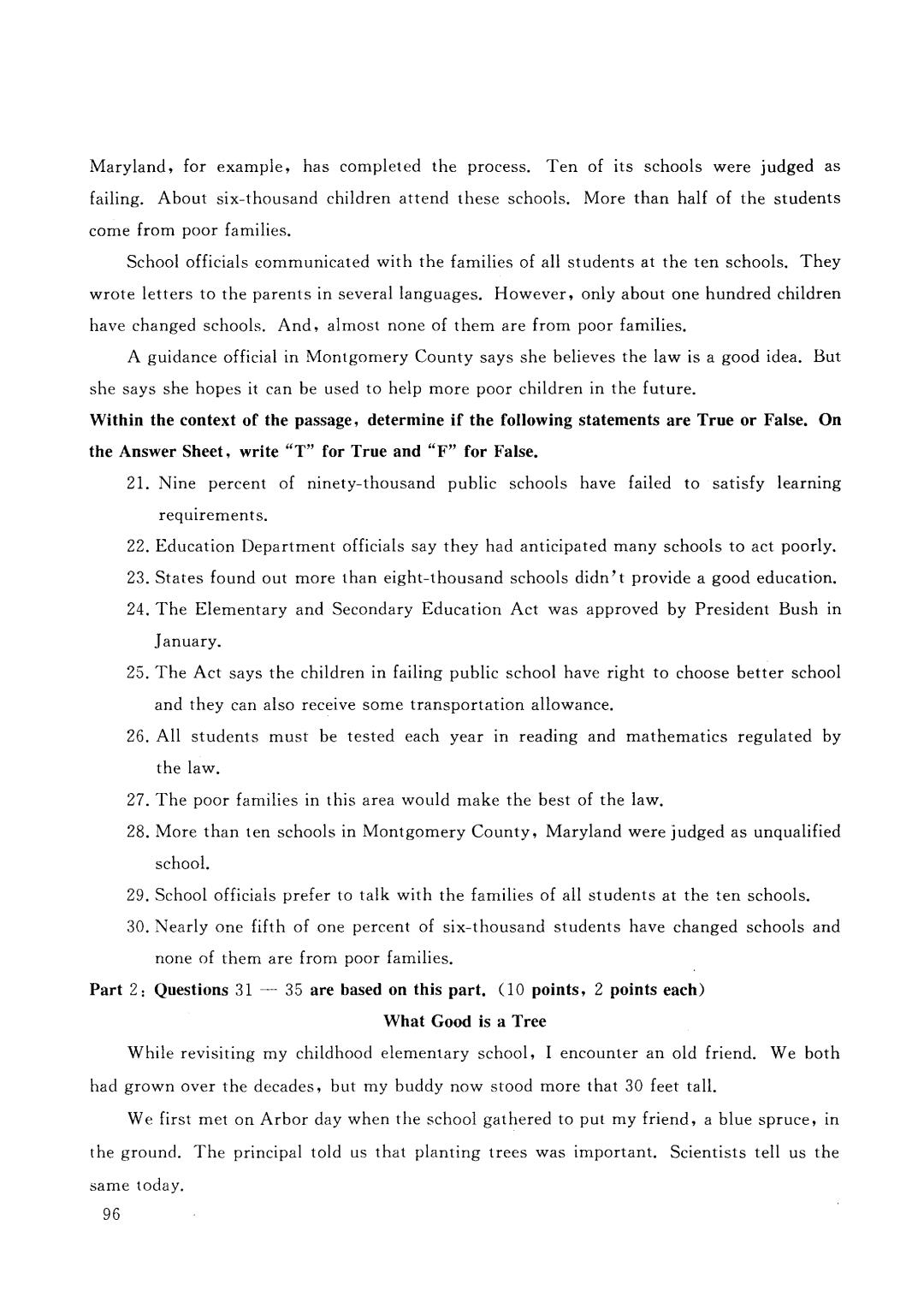
Maryland,for example,has completed the process.Ten of its schools were judged as failing.About six-thousand children attend these schools.More than half of the students come from poor families. School officials communicated with the families of all students at the ten schools.They wrote letters to the parents in several languages.However,only about one hundred children have changed schools.And,almost none of them are from poor families. A guidance official in Montgomery County says she believes the law is a good idea.But she says she hopes it can be used to help more poor children in the future. Within the context of the passage,determine if the following statements are True or False.On the Answer Sheet,write“T'for True and“F”for False. 21.Nine percent of ninety-thousand public schools have failed to satisfy learning requirements. 22.Education Department officials say they had anticipated many schools to act poorly. 23.States found out more than eight-thousand schools didn't provide a good education. 24.The Elementary and Secondary Education Act was approved by President Bush in January. 25.The Act says the children in failing public school have right to choose better school and they can also receive some transportation allowance. 26.All students must be tested each year in reading and mathematics regulated by the law. 27.The poor families in this area would make the best of the law. 28.More than ten schools in Montgomery County,Maryland were judged as unqualified school. 29.School officials prefer to talk with the families of all students at the ten schools. 30.Nearly one fifth of one percent of six-thousand students have changed schools and none of them are from poor families. Part 2:Questions 31-35 are based on this part.(10 points,2 points each) What Good is a Tree While revisiting my childhood elementary school,I encounter an old friend.We both had grown over the decades,but my buddy now stood more that 30 feet tall. We first met on Arbor day when the school gathered to put my friend,a blue spruce,in the ground.The principal told us that planting trees was important.Scientists tell us the same today. 96
Maryland , for example , has completed the process. Ten of its schools were judged as failing. About six-thousand children attend these schools. More than half of the students come from poor families. School officials communicated with the families of all students at the ten schools. They wrote letters to the parents in several languages. However, only about one hundred children have changed schools. And , almost none of them are from poor families. A guidance official in Montgomery County says she believes the law is a good idea. But she says she hopes it can be used to help more poor children in the future. Within the context of the passage , determine if the following statements are True or False. On the Answer Sheet , write "T" for True and "F" for False. 21. Nine percent of ninety-thousand public schools have failed to satisfy learning requirements. 22. Education Department officials say they had anticipated many schools to act poorly. 23. States found out more than eight-thousand schools didn' t provide a good education. 24. The Elementary and Secondary Education Act was approved by President Bush in January. 25. The Act says the children in failing public school have right to choose better school and they can also rec巳ive some transportation allowance. 26. All students must be tested each year in reading and mathematics regulated by the law. 27. The poor families in this area would make the best of the law. 28. More than ten schools in Montgomery County , Maryland were judged as unqualified school. 29. School officials prefer to talk with the families of all students at the ten schools. 30. Nearly one fifth of one percent of six-thousand students have changed schools and none of them are from poor families. Part 2: Questions 31 一35 are based on this part. (l0 points, 2 points each) Good is a Tree While revisiting my childhood elementary school , I encounter an old friend. We both had grown over the 巳cades but my buddy now stood more that 30 feet tall. We first met on Arbor day when the school gathered to put my friend , a blue spruce , in the ground. The principal told us that planting trees was important. Scientists tell us the sam巳today. 96
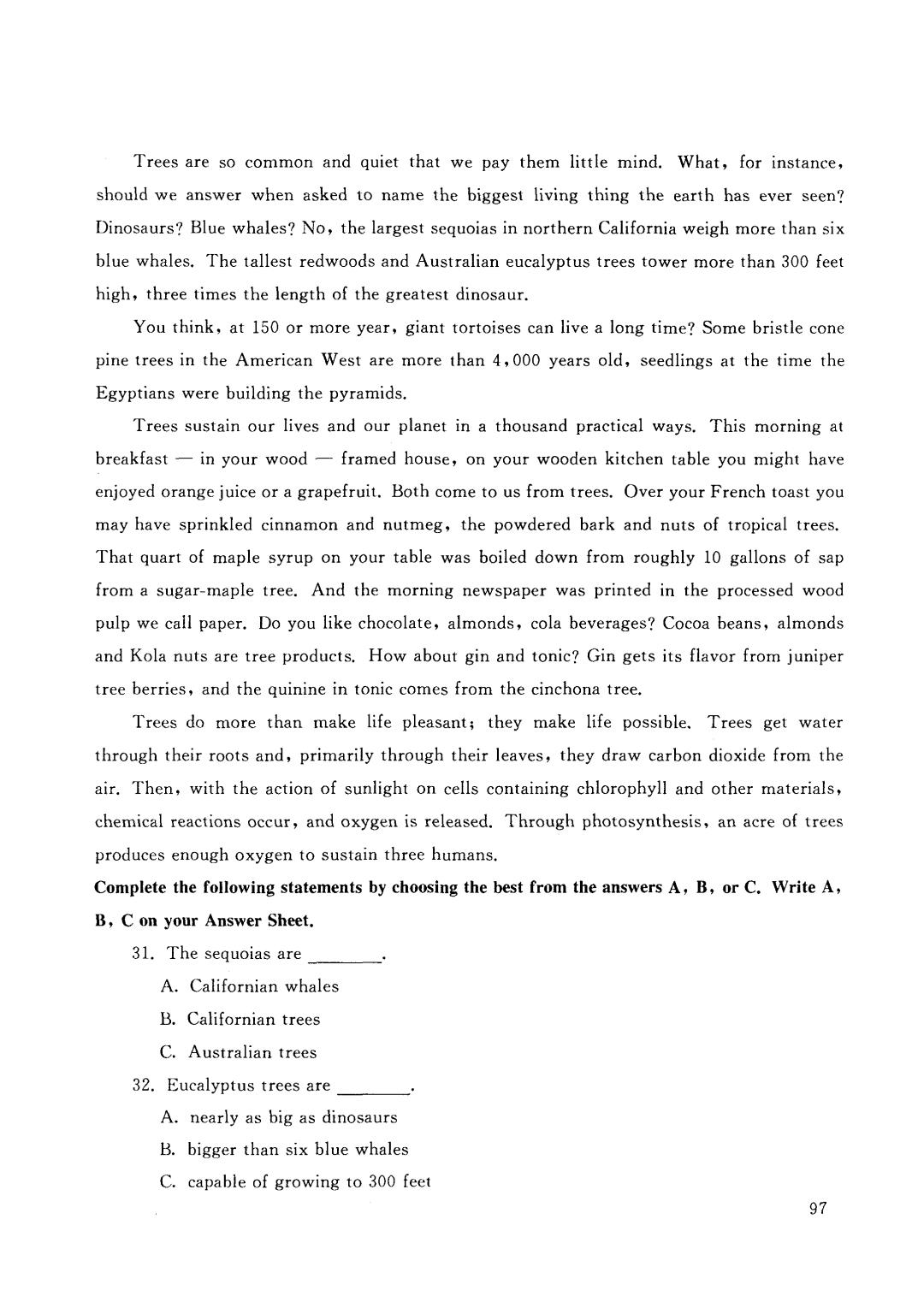
Trees are so common and quiet that we pay them little mind.What,for instance, should we answer when asked to name the biggest living thing the earth has ever seen? Dinosaurs?Blue whales?No,the largest sequoias in northern California weigh more than six blue whales.The tallest redwoods and Australian eucalyptus trees tower more than 300 feet high,three times the length of the greatest dinosaur. You think,at 150 or more year,giant tortoises can live a long time?Some bristle cone pine trees in the American West are more than 4,000 years old,seedlings at the time the Egyptians were building the pyramids. Trees sustain our lives and our planet in a thousand practical ways.This morning at breakfast-in your wood -framed house,on your wooden kitchen table you might have enjoyed orange juice or a grapefruit.Both come to us from trees.Over your French toast you may have sprinkled cinnamon and nutmeg,the powdered bark and nuts of tropical trees. That quart of maple syrup on your table was boiled down from roughly 10 gallons of sap from a sugar-maple tree.And the morning newspaper was printed in the processed wood pulp we call paper.Do you like chocolate,almonds,cola beverages?Cocoa beans,almonds and Kola nuts are tree products.How about gin and tonic?Gin gets its flavor from juniper tree berries,and the quinine in tonic comes from the cinchona tree. Trees do more than make life pleasant;they make life possible.Trees get water through their roots and,primarily through their leaves,they draw carbon dioxide from the air.Then,with the action of sunlight on cells containing chlorophyll and other materials, chemical reactions occur,and oxygen is released.Through photosynthesis,an acre of trees produces enough oxygen to sustain three humans. Complete the following statements by choosing the best from the answers A,B,or C.Write A, B,C on your Answer Sheet. 31.The sequoias are A.Californian whales B.Californian trees C.Australian trees 32.Eucalyptus trees are A.nearly as big as dinosaurs B.bigger than six blue whales C.capable of growing to 300 feet 97
• • Trees are so common and quiet that we pay them little mind. What , for instance , should we answer when asked to name the biggest living thing the earth has ever seen? Dinosaurs? Blue whales? No , the largest sequoias in northern California weigh more than six blue whales. The tallest redwoods and Australian eucalyptus trees tower more than 300 feet high , three times the length of the greatest dinosaur. You think , at 150 or more year , giant tortoises can live a long time? Some bristle cone pine trees in the American West are more than 4 ,000 years old , seedlings at the time the Egyptians were building the pyramids. Trees sustain our lives and our planet in a thousand practical ways. This morning at breakfast - in your wood 一framed house , on your wooden kitchen table you might have enjoyed orange juice or a grapefruit. Both come to us from trees. Over your French toast you may have sprinkled cinnamon and nutmeg , the powdered bark and nuts of tropical trees. That quart of maple syrup on your table was boiled down from roughly 10 gallons of sap from a sugar-maple tree. And the morning newspaper was printed in the processed wood pulp we call paper. Do you like chocolate , almonds, cola beverages? Cocoa beans, almonds and Kola nuts are tree products. How about gin and tonic? Gin gets its flavor from juniper tree berries, and the quinine in tonic comes from the cinchona tree. Trees do more than make life pleasant; they make life possible. Trees get water through their roots and , primarily through their leaves, they draw carbon dioxide from the air. Then , with the action of sunlight on cells containing chlorophyll and other materials, chemical reactions occur , and oxygen is released. Through photosynthesis, an acre of tr produc巳s enough oxygen to sustain three humans. Complete the following statements by choosing the best from the answers A , B, or C. Write A , B, C on your Answer Sheet. 31. The sequoias are A. Californian whales B. Californian trees C. Australian trees 32. Eucalyptus trees are A. nearly as big as dinosaurs B. bigger than six blue whales C. capable of growing to 300 feet 97

33.Trees provide people with A.furniture,spices,papers and nuts B.carbon dioxide and chlorine C.water,sugar and berries 34.Trees take in A.oxygen and sunlight B.water,carbon dioxide and sunlight C.chlorophyll and oxygen and sunlight 35.The reader may infer that A.the author is fond of trees B.the author is a chemist C.the author is a chemistry teacher Part 3:Questions 36-40 are based on this part.(20 points,4 points each) Travel in space Travel in space presented a big problem.How could an object get away from the pull of the earth?What was needed was a special engine.It would have to produce enough force to lift a spacecraft weighing many tons.Airplane engines use oxygen.There is no oxygen in space.So a spacecraft needs an engine that works without oxygen.Finding the right kind of engine took many years.Modern scientists used a very old idea-the rocket. A rocket is an engine that burns fuel and moves forward by pushing exhaust backward. Rockets operate by burning fuel in a tube.When the fuel burns,the hot gases produced are allowed to escape in one direction only.This causes a force to push in the opposite direction. Rockets do not need the presence of air.Any oxygen they need is in the fuel mixture that they burn. Rockets can be used to place satellites in orbit.The rocket provides the power for the satellite to get into space.Once the satellite is far enough away from earth,the rocket falls off.The satellite then circles around earth on its own. In 1957,the Soviet Union used a rocket to put the first spacecraft into orbit around earth.It was called Sputnik I.One year later,the United States sent a spacecraft named Explorer I into space.These events marked the start of the space age.Since then,powerful rockets have placed heavier satellites into orbit.They have carried astronauts to the moon. Rockets have launched space probes to fly near the other planets.Powerful computers help these spacecraft to stay on course. 98
33. Trees provide people with A. furniture , spices, papers and nuts B. carbon dioxide and chlorine C. water, sugar and berries 34. Trees take in A. oxygen and sunlight B. water, carbon dioxide and sunlight C. chlorophyll and oxygen and sunlight 35. The reader may infer that A. the author is fond of trees B. the author is a chemist C. the author is a chemistry teacher Part 3: Questions 36 40 are based on this part. (20 points, 4 points each) Travel in space Travel in space presented a big problem. How could an object get away from the pull of the earth? What was needed was a special engine. It would have to produce enough force to lift a spacecraft weighing many to日s. Airplane engines use oxygen. There is no oxygen in space. So a spacecraft needs an engine that works without oxygen. Finding the right kind of engine took many years. Modern scientists used a very old idea - the rocket. A rocket is an engine that burns fuel and moves forward by pushing exhaust backward. Rockets operate by burning fuel in a tube. When the fuel burns, the hot gases produced are allowed to escape in one direction only. This causes a force to push in the opposite direction. Rockets do not need the presence of air. Any oxygen they need is in the fuel mixture that they burn. Rockets can be used to place satellites in orbit. The rocket provides the power for the satellite to get into space. Once the satellite is far enough away from earth , the rocket falls off. The satellite then circles around earth on its own. In 1957 , the Soviet Union used a rocket to put the first spacecraft into orbit around earth. It was called Sputnik I. One year later, the United States sent a spacecraft named Explorer I into space. These 巳vents marked the start of the space age. Since then , powerful rockets have placed heavier satellites into orbit. They have carried astronauts to the moon. Rockets have launched space probes to fly near the other planets. Powerful computers help these spacecraft to stay on course. 98
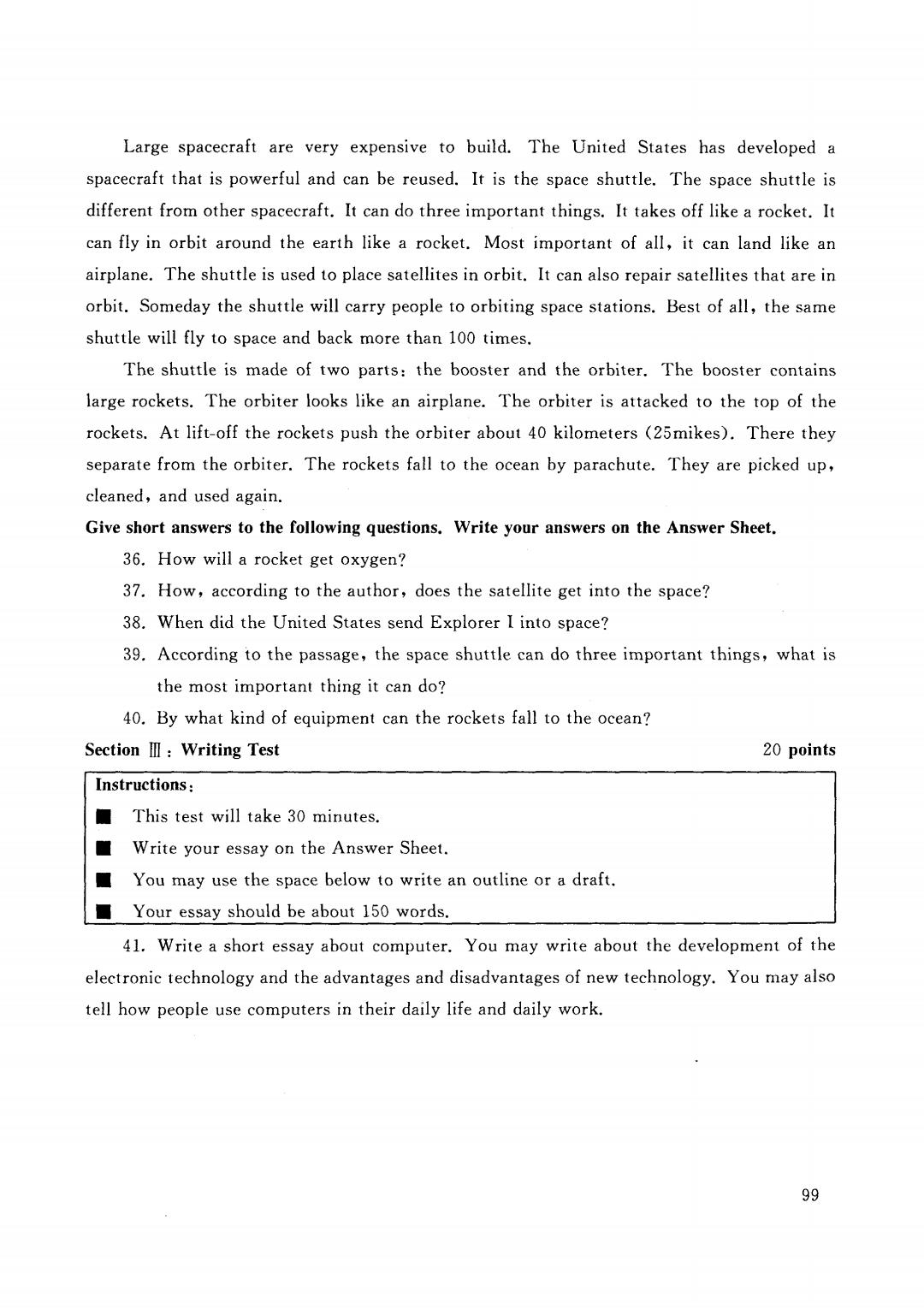
Large spacecraft are very expensive to build.The United States has developed a spacecraft that is powerful and can be reused.It is the space shuttle.The space shuttle is different from other spacecraft.It can do three important things.It takes off like a rocket.It can fly in orbit around the earth like a rocket.Most important of all,it can land like an airplane.The shuttle is used to place satellites in orbit.It can also repair satellites that are in orbit.Someday the shuttle will carry people to orbiting space stations.Best of all,the same shuttle will fly to space and back more than 100 times. The shuttle is made of two parts:the booster and the orbiter.The booster contains large rockets.The orbiter looks like an airplane.The orbiter is attacked to the top of the rockets.At lift-off the rockets push the orbiter about 40 kilometers (25mikes).There they separate from the orbiter.The rockets fall to the ocean by parachute.They are picked up, cleaned,and used again. Give short answers to the following questions.Write your answers on the Answer Sheet. 36.How will a rocket get oxygen? 37.How,according to the author,does the satellite get into the space? 38.When did the United States send Explorer I into space? 39.According to the passage,the space shuttle can do three important things,what is the most important thing it can do? 40.By what kind of equipment can the rockets fall to the ocean? SectionⅢ:Writing Test 20 points Instructions: This test will take 30 minutes. Write your essay on the Answer Sheet. You may use the space below to write an outline or a draft Your essay should be about 150 words. 41.Write a short essay about computer.You may write about the development of the electronic technology and the advantages and disadvantages of new technology.You may also tell how people use computers in their daily life and daily work. 99
Large spacecraft are very expensive to build. The United States has developed a spacecraft that is powerful and can be reused. It is the space shuttle. The space shuttle is different from other spacecraft. It can do three important things. It takes off like a rocket. It can fly in orbit around the earth like a rocket. Most important of all. it can land like an airplane. The shuttle is used to place satellites in orbit. It can also repair satellites that are in orbit. Someday the shuttle will carry people to orbiting space stations. Best of all. the same shuttle will fly to space and back more than 100 times. The shuttle is made of two parts: the booster and the orbiter. The booster contains large rockets. The orbiter looks like an airplane. The orbiter is attacked to the top of the rockets. At lift-off the rockets push the orbiter about 40 kilometers (25mikes). There they separate from the orbiter. The rockets fall to the ocean by parachute. They are picked up. cleaned. and used again. Give short answers to the following questions. Write your answers on the Answer Sheet. 36. How will a rocket get oxygen? 37. How. according to the author. does the satellite get into the space? 38. When did the United States send Explorer I into space? 39. According to the passage. the space shuttle can do three important things. what is the most important thing it can do? 40. By what kind of equipment can the rockets fall to the ocean? Section III : Writing Test 20 points Instructions: • This test will take 30 minutes. • Write your essay on the Answer Sheet. • You may use the space below to write an outline or a draft. o ur essay should be about 150 words. 41. Write a short essay about computer. You may write about the development of the electronic technology and the advantages and disadvantages of new technology. You may also tell how people use computers in their daily life and daily work. 99
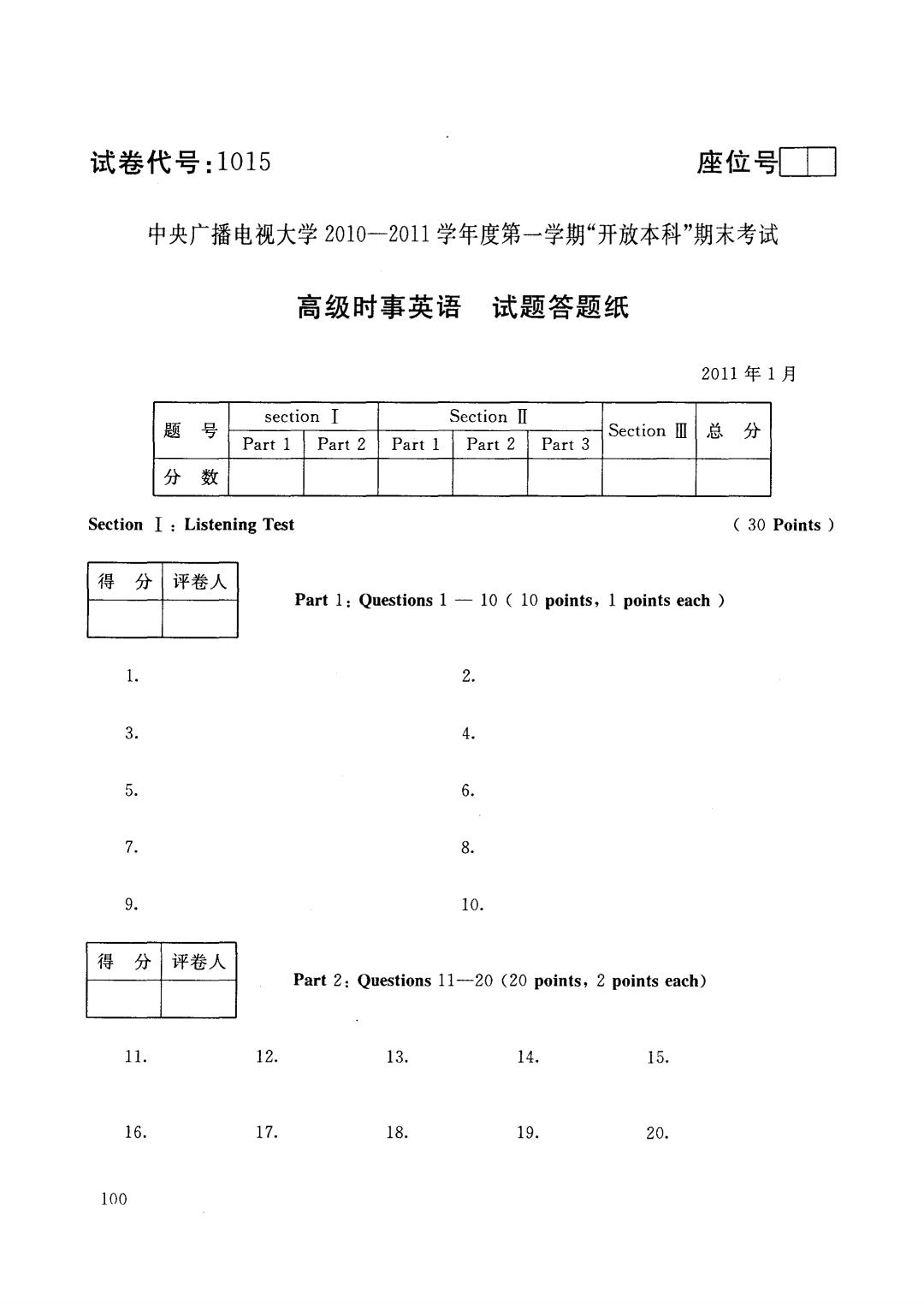
试卷代号:1015 座位号■■ 中央广播电视大学2010一2011学年度第一学期“开放本科”期末考试 高级时事英语 试题答题纸 2011年1月 section I Section II 题 号 SectionⅢ 总 分 Part 1 Part 2 Part 1 Part 2 Part 3 分 数 Section I Listening Test 30 Points 得 分 评卷人 Part 1:Questions 1-10 10 points,1 points each 1. 2. 3. 4. 5. 6. 7 8 9. 10. 得分 评卷人 Part 2:Questions 11-20 (20 points,2 points each) 11. 12. 13. 14. 15. 16. 17. 18. 19. 20. 100
试卷代号 座位号 中央广播电视大学 2011 学年度 高级时事英语试题答题纸 2011 年1 section I Section II Section ,总 Part 1 Part 2 Part 1 Part 2 Part 3 Section I : Listening Test 得分|评卷入 3. 5. 7. 9. ( 30 Points) Part 1: Questions 1 - 10 ( 10 points, 1 points each) 2. 4. 6. 8. 10. 得分|评卷人 Part 2: Questions 11-20 (20 points, 2 points each) 11. 16. 100 12. 17. 13. 18. 14. 19. 15. 20
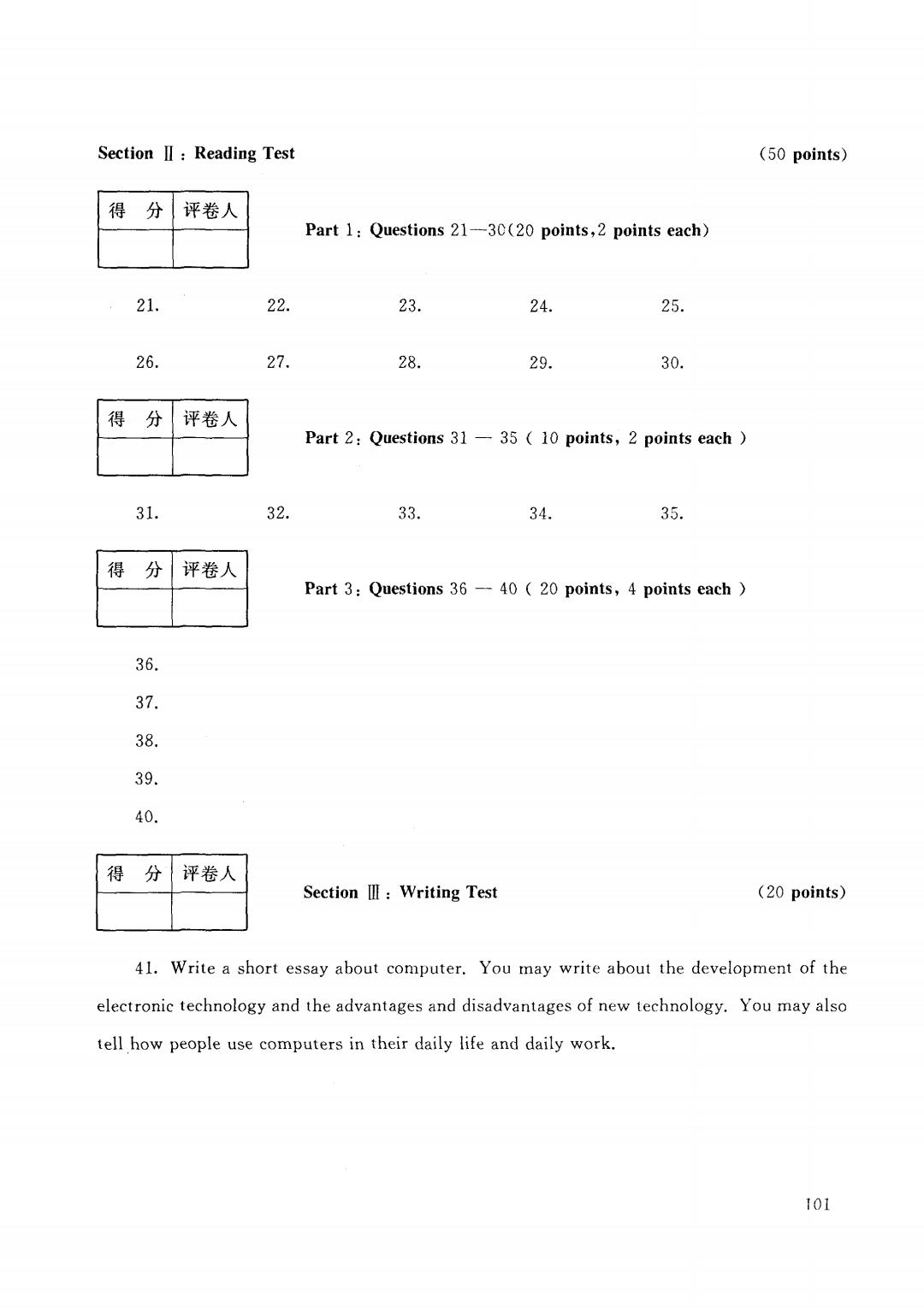
SectionⅡ:Reading Test (50 points) 得 分 评卷人 Part 1:Questions 21-30(20 points,2 points each) 21. 22. 23. 24. 25. 26. 27. 28. 29. 30. 得 分 评卷人 Part 2:Questions 31-35 10 points,2 points each 31. 32. 33. 34. 35. 得 分 评卷人 Part 3:Questions 36-40 20 points,4 points each 36. 37. 38. 39. 40. 得 分 评卷人 SectionⅢ:Writing Test (20 points) 41.Write a short essay about computer.You may write about the development of the electronic technology and the advantages and disadvantages of new technology.You may also tell how people use computers in their daily life and daily work. 101
Section II : Reading Test 得分|评卷人 Part 1: Questions 21 一30(20 points,2 points each) (50 points) 21. 26. 22. 27. 23. 28. 24. 29. 25. 30. 得分|评卷人 Part 2: Questions 31 - 35 ( 10 points, 2 points each) 31. 32. 33. 34. 35. 得分|评卷人 36. 37. 38. 39. 40. 得分!评卷人 Part 3: Questions 36 - 40 ( 20 points, 4 points each) Section Writing Test (20 points) 41. Write a short essay about computer. You may write about the development of the electronic technology and the advantages and disadvantages of new technology. You may also tell how people use computers in their daily life and daily work. 101

试卷代号:1015 中央广播电视大学2010一2011学年度第一学期“开放本科”期末考试 高级时事英语 试题答案及评分标准 (供参考) 2011年1月 Section I:Listening (20 minutes) (30 points) Key to Listening Test Total =30 points Part 1:One point for each correct answer Total =10 points 1.anything 2.Internet 3.information 4.individual 5.fellow 6.luxury 7.Internet 8.tailored (suited) 9.what 10.whenever (The answer 9-10 are interchangeable) Part 2:True or False:Two points for each correct answer Total =20points 1.F 12.F 13.T 14.T 15.F 16.F 17.T 18.T 19.F 20.T SectionⅡ:Reading(40 minutes). (50 points) Part 1:2 points for each correct answer Total =20 points 21.T 22.F 23.T 24.T 25.T 26.F 27.F 28.F 29.F 30.F 102
试卷代号 中央广播电视大学 2011 第 一 开放 高级时事英语试题答案及评分标准 (供参考) Section I : Listening (20 minutes) 2011 年1 (30 points) Key to Listening Test Total = 30 points Part 1: One point for each correct answer 1. anything 2. Internet 3. information 4. individual 5. fellow 6. luxury 7. Internet 8. tailored (suited) 9. what Total = 10 points 10. whenever (The answer 9-10 are interchangeable) Part 2: True or False: Two points for each correct answer AI. F 16. F 12. F 17. T 13. T 18. T 14. T 19. F Total = 20points 15. F 20. T Section II : Reading (40 minutes) Part 1: 2 points for each correct answer 21. T 26. F 102 22. F 27. F 23. T 28. F Total = 20 points 24. T 29. F 25. T 30. F (50 points)